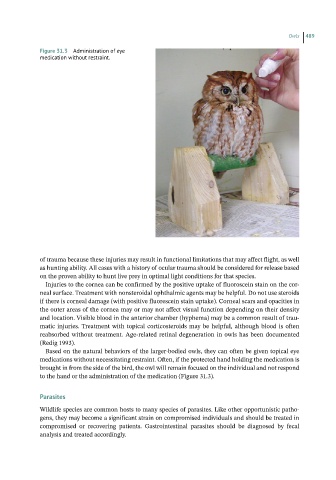Page 493 - Hand rearing birds second
P. 493
Owls 489
Figure31.3 Administration of eye
medication without restraint.
of trauma because these injuries may result in functional limitations that may affect flight, as well
as hunting ability. All cases with a history of ocular trauma should be considered for release based
on the proven ability to hunt live prey in optimal light conditions for that species.
Injuries to the cornea can be confirmed by the positive uptake of fluoroscein stain on the cor-
neal surface. Treatment with nonsteroidal ophthalmic agents may be helpful. Do not use steroids
if there is corneal damage (with positive fluorescein stain uptake). Corneal scars and opacities in
the outer areas of the cornea may or may not affect visual function depending on their density
and location. Visible blood in the anterior chamber (hyphema) may be a common result of trau-
matic injuries. Treatment with topical corticosteroids may be helpful, although blood is often
reabsorbed without treatment. Age‐related retinal degeneration in owls has been documented
(Redig 1993).
Based on the natural behaviors of the larger‐bodied owls, they can often be given topical eye
medications without necessitating restraint. Often, if the protected hand holding the medication is
brought in from the side of the bird, the owl will remain focused on the individual and not respond
to the hand or the administration of the medication (Figure 31.3).
Parasites
Wildlife species are common hosts to many species of parasites. Like other opportunistic patho-
gens, they may become a significant strain on compromised individuals and should be treated in
compromised or recovering patients. Gastrointestinal parasites should be diagnosed by fecal
analysis and treated accordingly.

